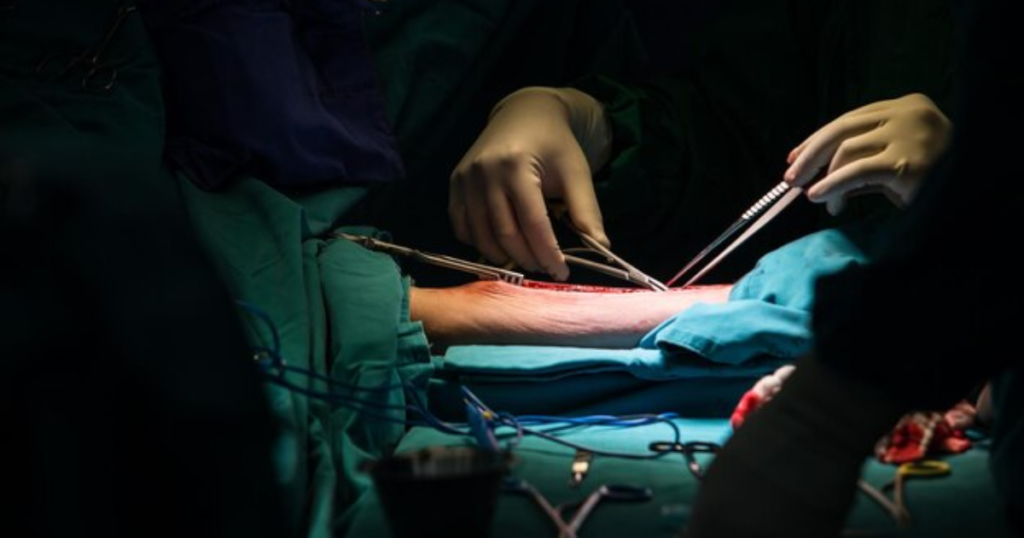The Loop Electrosurgical Excision Procedure (LEEP) is a standard medical therapy that removes aberrant cervical tissue. Following the treatment, patients may develop a scab at the location where the tissue was removed. Understanding what happens when scab falls off after leep and how it is critical for post-treatment care and healing.
Following a LEEP (Loop Electrosurgical Excision Procedure), the patient may endure bleeding and discomfort. The scab that forms over the wound will naturally fall off. This is a natural aspect of the healing process. New skin will grow underneath, and the region will progressively fade in colour.
The time of a LEEP scab peeling off varies, although it often occurs 2 to 3 weeks following the operation. However, this schedule may vary depending on individual characteristics such as the body’s recovery rate and the length of the treatment. As the healing process advances, the scab detaches and may produce a dark, coffee-ground-like discharge.
What is a LEEP Procedure?
A LEEP (Loop Electrosurgical Excision technique) is a medical technique for removing abnormal cells from the cervix, the bottom section of the uterus that links to the vagina. During the process, a small wire loop carrying an electric current is utilised to cut away the aberrant tissue. LEEP is frequently performed when abnormal cells are discovered via a Pap smear or colposcopy, which are procedures designed to detect cervical cancer or other abnormalities. The operation is usually performed as an outpatient and is regarded safe and effective for eliminating precancerous or cancerous cells from the cervix.
Why Should You Choose Leep?
Your healthcare physician may propose a Loop Electrosurgical Excision Procedure (LEEP) for a variety of reasons.
- Effective Treatment: Effective in removing abnormal cervical cells, especially those caused by HPV infection.
- Minimally Invasive: Can be performed in a doctor’s office or outpatient setting, requiring only local anesthesia.
- Preserves Fertility: Selectively removes abnormal tissue while preserving healthy tissue, aiding future conception.
- Quick Recovery: Most women recover quickly, often returning to normal activities within a day or two.
- Outpatient Procedure: Can be performed as an outpatient procedure, reducing hospitalization.
- Early Detection and Treatment: Allows early detection and treatment of abnormal cervical cells, reducing risk of cervical cancer.
- Minimal Scarring: Preserves cervical function and reduces risk of future pregnancies.
What Happens During A LEEP?
A Loop Electrosurgical Excision Procedure (LEEP) is a specialised procedure that removes abnormal cervical tissue. First, you will lie down on a table for a pelvic exam. Then, a doctor inserts a speculum inside you to examine your cervix. They ensure that you are not in pain by administering sleeping medication. They then use a little wire loop to snip away the odd tissue. The doctor decides how much tissue to remove. They transmit what they cut to a lab for analysis. After that, you relax and feel better. You’ll have more visits to discuss what happened and what’s next. If you’re wondering what happens when the scab falls off after LEEP, it’s a natural part of the healing process.

How Painful Is The LEEP Procedure?
The intensity of pain felt after a LEEP operation varies from person to person. Some people may feel just slight discomfort as a result of the operation, while others may have more acute symptoms.
Before the LEEP, a local anaesthetic is usually administered to the cervix to numb the area and reduce pain during the process. However, some people may experience pressure, cramping, or a burning feeling as the aberrant tissue is removed.
Many women believe that having a LEEP isn’t too bad, much like getting a Pap smear or a cervical biopsy. However, if you are concerned about the pain, you can consult your doctor before to the treatment. They may have solutions to help with the pain or make you feel better throughout the LEEP. Your doctor can also describe what happens when the scab falls off following a LEEP.
The Pros And Cons Of LEEP
The Loop Electrosurgical Excision Procedure (LEEP) is a standard surgical procedure for treating aberrant cervical cells. LEEP, like any other medical procedure, has both advantages and disadvantages:
Pros:
- Effective Treatment: LEEP is an efficient treatment for eliminating aberrant cervical cells, particularly those caused by HPV (Human Papillomavirus) infection. It helps to prevent these abnormal cells from progressing to cervical cancer.
- Outpatient Procedure: LEEP is usually done as an outpatient procedure in a doctor’s office or clinic. It does not involve hospitalisation, which may make it more convenient for patients.
- Quick Recovery: Most women heal rapidly from LEEP, with many returning to normal activities within a day or two. Compared to more intrusive surgical procedures, the recovery time is brief.
- Preservation of Fertility: LEEP preserves fertility by selectively removing aberrant tissue from the cervix while keeping healthy tissue intact. This helps protect fertility for women who want to conceive in the future.
Cons:
- Potential Side Effects: Some women may have cramps, bleeding, or discharge following LEEP. These side effects are often mild and transient, although they might be troublesome for some people.
- Complications of LEEP: Infection, haemorrhage, and cervix injury are all possible, though rare. These risks are typically modest, but they should be discussed with your healthcare provider before to the surgery.
- Cervical Stenosis: In some circumstances, LEEP can result in scarring or narrowing of the cervix. Although uncommon, this can have an impact on fertility and menstruation.
- Potential for Recurrence: While LEEP effectively removes aberrant cells, there is a risk of recurrence in the future. Regular follow-up exams and Pap tests are necessary to monitor cervical health following LEEP.
- mental Impact: For some women, being diagnosed with abnormal cervical cells and being required to undergo therapy such as LEEP can cause anxiety or mental discomfort. It is critical to share any concerns or emotions with your healthcare professional or a counsellor.
Overall, LEEP is an effective treatment for aberrant cervical cells and reduces the risk of cervical cancer. However, like any medical intervention, it is critical to discuss the potential advantages and dangers with your healthcare physician in order to make an informed decision.

The Side Effects Of LEEP
While LEEP effectively removes aberrant cells, there is a risk of recurrence in the future. Regular follow-up exams and Pap tests are necessary to monitor cervical health following LEEP.
- mental Impact: For some women, being diagnosed with abnormal cervical cells and being required to undergo therapy such as LEEP can cause anxiety or mental discomfort. It is critical to share any concerns or emotions with your healthcare professional or a counsellor.
- Bleeding: Overall, LEEP is an effective treatment for aberrant cervical cells and reduces the risk of cervical cancer. However, like any medical intervention, it is critical to discuss the potential advantages and dangers with your healthcare physician in order to make an informed decision.
- Pain or Discomfort: It is typical to feel some pain or discomfort in the pelvis following LEEP. This could include discomfort, hurting, or a feeling of pressure. Over-the-counter pain medicines and prescription medications can aid with discomfort.
- chance of Infection: Although uncommon, there is a slight chance of infection following LEEP. Infection symptoms include fever, severe pelvic pain, foul-smelling discharge, and increased pain or bleeding. If you encounter any of these symptoms, you should consult your healthcare professional.
- Scar Tissue Formation: In some situations, LEEP can cause the cervix to generate scar tissue. This can result in cervical stenosis, a narrowing of the cervical aperture that might impair fertility or menstruation. However, this is a rare issue.
- Emotional anguish: For some women, being diagnosed with aberrant cervical cells and receiving therapy such as LEEP can cause emotional anguish or anxiety. It is critical to seek assistance from healthcare providers, counsellors, or support groups as needed.
It is crucial to note that, while these side effects are possible, most women handle LEEP well and feel little discomfort. However, if you are concerned about potential side effects or suffer odd symptoms following the surgery, please contact your healthcare professional for advice and support.
What Is Scab Formation After LEEP
Following the LEEP operation, your body begins to recover itself. This means it attempts to repair the place where the tissue was removed. A scab forms where the tissue was removed, similar to what happens when you scrape your knee. This scab is important because it keeps the area from becoming infected and promotes new tissue growth underneath. So, what happens when the scab falls off following LEEP.
When Does The LEEP Scab Fall Off?
After a Loop Electrosurgical Excision Procedure (LEEP), the cervix scab usually peels off within a few weeks. The exact timing varies from person to person, but the scab typically sheds between 1 and 4 weeks after the operation. During this time, you may notice some vaginal discharge, which is a natural part of the healing process when the scab falls off. To maintain adequate healing and monitoring of your cervical health, you must follow any post-procedure recommendations offered by your healthcare professional and attend any follow-up consultations. If you are concerned about the timing or appearance of the scab, please contact your healthcare professional for assistance.
What Happens When Scab Falls Off After LEEP
1. Scab Detachment
As the wound heals, the scab acts as a protective barrier, shielding the surrounding tissue. The scab eventually detaches from the skin surface as a result of the body’s natural healing mechanisms. This process normally takes one to two weeks after the LEEP operation.
2. Sensation of Itching
As the scab loosens and falls off, patients may experience irritation in the treatment region. This itchy feeling is widespread and is frequently ascribed to the body’s natural healing process. While it may be tempting to scratch the region, resist the impulse to do so in order to avoid disrupting the healing process.
3. Appearance of Pink Skin
When the scab slips off, patients may discover that the skin beneath is pink or slightly discoloured. This is a typical aspect of the healing process and a sign of new skin creation. Over time, the skin will recover and return to its natural colouring.
4. Minimal Bleeding
Minimal bleeding may occur as the scab detaches from the skin’s surface. This is usually mild and should pass fast. However, if bleeding continues or becomes significant, it is critical to see a doctor for additional assessment.
5. Tender Skin Sensation
After the scab breaks off, patients may feel sore in the treated area. This is natural and is caused by the skin’s increased sensitivity as it heals. Applying a moderate moisturiser or soothing ointment will help relieve discomfort and encourage healing.
6. Avoidance of Physical Irritation
To ensure maximum recovery, prevent any physical discomfort to the treated region. This includes not picking or scratching at the skin and avoiding tight clothing that can rub against the healing location. By reducing discomfort, patients can promote faster healing and lower their risk of problems.
Tips for Faster Healing After Scab Falls Off
Following post-procedure instructions and maintaining good hygiene are crucial for faster healing after a Loop Electrosurgical Excision Procedure (LEEP). Staying hydrated, eating a balanced diet, avoiding strenuous activities, managing discomfort with over-the-counter pain relievers, monitoring for signs of infection, resting and relaxing, attending follow-up appointments, and practicing patience are essential for a successful recovery. It is important to follow healthcare provider’s instructions, avoid strenuous activities, and monitor your healing progress. It is also important to be patient with yourself and trust that your body is working to heal the treated area.

What Should I Expect After Receiving A Leep?
Following a Loop Electrosurgical Excision Procedure (LEEP), patients may experience cramping, spotting, or light bleeding immediately after the procedure. They may feel tired or lightheaded due to the stress. Vaginal discharge, ranging from watery to bloody, may persist for several weeks. Pain and discomfort may occur, with over-the-counter pain relievers like ibuprofen helpful.
Following a LEEP operation, you may need to rest for a brief period of time, which may require you to avoid certain activities. But don’t panic; you’ll be back to your usual regimen in a day or two. It is critical to schedule check-ups with your doctor to ensure that you are healing appropriately and to discuss any concerns you may have. Some women may benefit from additional emotional assistance at this time.
Most women recover without incident, but if you begin to have severe pain, excessive bleeding, or fever, you should contact your doctor right soon so that they can aid you. Your doctor can also describe what happens when the scab falls off following a LEEP.
Is It Normal To Have Black Smelly Discharge After LEEP?
Black, foul-smelling discharge following a LEEP operation is not normal and could suggest a problem like infection or tissue necrosis. While some discharge and odour are to be expected during the healing process, they should not be dark or foul-smelling.
If you have black, foul-smelling discharge following a LEEP operation, contact your healthcare professional right away for an assessment and treatment. They can evaluate the issue, identify the underlying cause, and administer proper medical therapy. Prompt medical assistance is critical to avoiding complications and ensuring your rehabilitation goes smoothly.
Common Misconceptions About Scab Fall Off After LEEP
Misconceptions about scab falling off after a LEEP (Loop Electrosurgical Excision Procedure) are common. It’s normal for the scab to fall off within a few weeks, but excessive bleeding, foul odor, or severe pain could indicate an infection. The size of the scab doesn’t necessarily indicate the severity of the condition or the success of the procedure. Healing may take several weeks, and it’s essential to follow post-operative care instructions. Discharge after the scab falls off is normal, but foul-smelling, severe pain, or fever could indicate an infection. Regular follow-up appointments are necessary to monitor for recurrence or persistence of abnormal cells.
Psychological Impact of Scab Fall Off After LEEP
When a scab slips off following a medical surgery such as a LEEP, people may experience a variety of emotions. Some people may become concerned because they are frightened something may go wrong or that the surgery will not work. Others may feel better because they understand their body is repairing itself. The entire process of getting healthier might be like a rollercoaster with many ups and downs. It’s common to have a range of emotions throughout this period. As a result, everyone’s experience with What Happens When Scab Falls Off After LEEP is unique.
Fear of recurrence and body image concerns may arise. Coping strategies include seeking support from friends, family, or healthcare providers, practicing relaxation techniques, and engaging in comforting activities. Open communication with healthcare providers can also help alleviate psychological distress. Overall, it’s crucial for individuals to be aware of their emotional responses and seek support to navigate the healing process effectively.
Read More: Why Did My Pores Get Bigger All of a Sudden
Conclusion
Finally, understanding what happens when the scab breaks off during LEEP is critical for patients undergoing this surgery. Patients can enhance recovery and achieve the best possible results by following post-treatment care recommendations and attending regular follow-up visits.
Frequently Asked Question
What happens when a scab falls off following LEEP?
When the scab slips off following a LEEP operation, it indicates that your body is mending. If you receive a scrape on your knee, your body creates a scab to protect the wound. When the scab slips off, it implies the skin underneath is healing well.
Is it usual for the scab to fall off following LEEP?
Yes, it is quite normal! Imagine pulling off a bandage after a cut has begun to heal. The scab breaking off is simply part of your body’s normal healing process.
What should I do if the scab falls off following LEEP?
There is no need to do anything unusual when the scab slips off. Just keep taking care of yourself as your doctor has advised. Make careful to follow any directions they provided you regarding keeping the space clean and avoiding specific activities.
Will it hurt if the scab peels off following LEEP?
When the scab slips off, the area may feel tender or sensitive, but it should not be painful. It may feel strange when a scab on your knee falls off, but it is not cause for concern.
How long does it take for the scab to fall off following LEEP?
It varies from person to person, but the scab often falls off after a few weeks of the LEEP operation. Your body understands how to repair itself, so be patient. If you’re anxious about how long it’ll take, consult your doctor for reassurance.









Leave a Reply